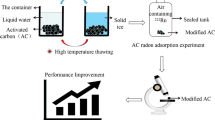Abstract
Radon is a significant background source in rare event detection experiments. Activated carbon (AC) adsorption is widely used for effective radon removal. The selection of AC considers its adsorption capacity and radioactive background. In this study, using self-developed devices, we screened and identified a new kind of low-background AC from Qingdao Inaf Technology Company that has very high Radon adsorption capacity. By adjusting the average pore size to 2.3 nm, this AC demonstrates a radon adsorption capacity of 2.6 or 4.7 times higher than Saratech or Carboact activated carbon under the same conditions.







Similar content being viewed by others
Data availability
Data will be made available on request.
References
JUNO Collaboration (2022) JUNO physics and detector. Prog Part Nucl Phys 123:103927
Alimonti G et al (2009) The Borexino detector at the Laboratori Nazionali Del Gran Sasso. Nucl Instrum Meth A 600:568–593
Fukuda S et al (2003) The super-kamiokande detector. Nucl Instrum Meth A 501:418–462
Aprile E et al (2017) The XENON1T dark matter experiment. Eur Phys J C 77:881
Bonet H et al (2021) Constraints on elastic neutrino nucleus scattering in the fully coherent regime from the CONUS experiment. Phys Rev Lett 126:041804
Guo C et al (2020) The liquid argon detector and measurement of SiPM array at liquid argon temperature. Nucl Instrum Meth A 980:164488
Baudis L et al (2018) A dual-phase xenon TPC for scintillation and ionization yield measurements in liquid xenon. Eur Phys J C 78:351
Akimov D et al (2018) COHERENT 2018 at the Spallation Neutron source. DOI arXiv:1803.09183
Angloher G et al (2021) First measurements of remoTES cryogenic calorimeters:easy-to-fabricate particle detectors for a wide choice of target materials. Nucl Instrum Meth A 1045:167532
Aprile E et al (2021) 222Rn emanation measurements for the XENON1T experiment. Eur Phys J C 81:337
Liu Y et al (2023) System upgrade for µBq/m3 level 222Rn concentration measurement. JINST 18:T03002
Simgen H et al (2009) Analysis of the 222Rn concentration in argon and a purification technique for gaseous and liquid argon. Appl Radiat Isot 67:922–925
Abe K et al (2012) Radon removal from gaseous xenon with activated charcoal. Nucl Instrum Meth A 661:50–57
Pushkin K et al (2018) Study of radon reduction in gases for rare event search experiments. Nucl Instrum Meth A 903:267–276
Nakano Y et al (2017) Measurement of radon concentration in Super-kamiokande’s buffer gas. Nucl Instrum Meth A 867:108–114
Heusser G et al (2000) 222Rn detection at the µBq/m3 range in nitrogen gas and a new rn purification technique for liquid nitrogen. Appl Radiat Isot 52:691–695
Yu X et al (2020) Radon activity measurement of JUNO nitrogen. JINST 15:P09001
Saratech charcoal specification. https://www.bluecher.com/en/. Accessed 13 July 2023
Carboact charcoal specification. https://www.carboactinternational.com/. Accessed 13 July 2023
Hanchurak Stephen R (2014) Development of a high sensitivity radon emanation detector. University of Alberta, Canada
Soule B (2013) Radon emanation chamber: high sensitivity measurements for the SuperNEMO experiment. AIP Conf Proc 1549:98–101
Chen YY et al (2022) A study on the radon removal performance of low background activated carbon. JINST 17:P02003
Guo L et al (2017) The temperature dependence of adsorption coefficients of 222Rn on activated charcoal: an experimental study. Appl Radiat Isot 125:185–187
Nakano Y et al (2020) Evaluation of radon adsorption efficiency values in xenon with activated carbon fibers. Prog Theor Exp Phys 2020:13H01
Qiao B et al (2011) Dynamic adsorption properties of activated carbon for radioactive noble gas treatment in offshore floating nuclear power plant. J Radioanal Nucl Chem 327:207–215
Wang F et al (2023) Radon dynamic adsorption coefficients of two activated charcoals at different temperatures in nitrogen environment. Appl Radiat Isot 191:110564
Li C et al (2022) Construction of a low-temperature activated carbon radon adsorption system using air cooler. J Radio-anal Nucl Chem 331:1839–1845
Wang Q et al (2011) An experimental study on radon adsorption ability and microstructure of activated carbon. Nucl Sci Eng 168(3):287–292
Aalseth CE et al (2020) Design and construction of a new detector to measure ultra-low radioactive-isotope contamination of argon. JINST 15:P02024
Rupp N (2017) Radon background in liquid xenon detectors. JINST 13:C02001
Agnes P et al (2019) Measurement of the ion fraction and mobility of 218Po produced in 222Rn decays in liquid argon. JINST 14:P11018
Acknowledgements
This work is supported by the State Key Laboratory of Particle Detection and Electronics (Grant No. SKLPDE-ZZ-202304), the Youth Innovation Promotion Association of the Chinese Academy of Sciences (Grant No. 2023015), and the Yalong River Joint Fund of the National Natural Science Foundation of China and Yalong River Hydropower Development Co., LTD (Grant No. U1865208).
Author information
Authors and Affiliations
Corresponding authors
Ethics declarations
Conflict of interest
The authors declare no conflict of interest.
Additional information
Publisher’s Note
Springer Nature remains neutral with regard to jurisdictional claims in published maps and institutional affiliations.
Rights and permissions
Springer Nature or its licensor (e.g. a society or other partner) holds exclusive rights to this article under a publishing agreement with the author(s) or other rightsholder(s); author self-archiving of the accepted manuscript version of this article is solely governed by the terms of such publishing agreement and applicable law.
About this article
Cite this article
Li, C., Zhang, Y., Lv, L. et al. Study on the radon adsorption capability of low-background activated carbon. J Radioanal Nucl Chem 333, 337–346 (2024). https://doi.org/10.1007/s10967-023-09211-w
Received:
Accepted:
Published:
Issue Date:
DOI: https://doi.org/10.1007/s10967-023-09211-w




